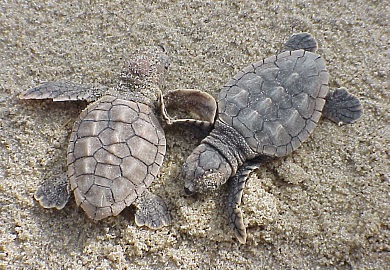
Nesting season for loggerhead sea turtles is on. The first clutch of loggerhead eggs was found this week buried in the sand on a Cumberland Island beach.
The nest, made Saturday night, marked Georgia’s 32nd year of comprehensive marine turtle nest monitoring and the seventh straight year that Cumberland National Seashore had the first nest. Georgia Sea Turtle Program Coordinator Mark Dodd said the state’s southernmost barrier island has plenty of beach-nesting habitat, a number of female loggerheads that tend to nest there and a very dedicated Georgia Sea Turtle Cooperative member, wildlife biologist Doug Hoffman of the National Park Service.
“He’s just a maniac” about checking the beach and protecting sea turtle nests, Dodd said.
But Cumberland is only the start. Loggerheads, Georgia’s leading marine turtle and a protected species, nest on all barrier islands in the state. The season will hit full stride by June.
Predicting a nest total is anyone’s guess, according to Dodd, a senior wildlife biologist with the Georgia Department of Natural Resources. But one question is whether 2020 can top last year’s 3,950 nests, the most since extensive monitoring began in 1989.
The state’s previous record was 3,289 nests in 2016. That count also marked the first time the big, chunky-headed marine turtles had topped a Georgia recovery benchmark of 2,800 nests.
“The loggerhead population was declining through the early 1990s,” Dodd said. “Since then, it’s been increasing at approximately 4 percent annually.”
While nesting year to year has been highly variable in the state, with the overall gains this species federally listed as threatened is making steady progress toward recovery. Nesting in Florida and the Carolinas is also increasing.
Continuing that rebound is the goal of Georgia’s Sea Turtle Cooperative. The DNR-coordinated network of about 200 volunteers, researchers and agency employees patrols beaches daily during nesting season. Working under a federal permit, members mark, monitor and protect all loggerhead nests, plus those of other species that seldom nest in Georgia, such as green and Kemp’s ridley.
The effort not only eases predation and increases the number of young that hatch, the data collected is used to assess loggerhead populations, assess threats and inform management. Cooperators also help with beach management. It’s an effort that has been in play on Georgia beaches for more than 30 years.
“The cooperative has done a tremendous amount of work,” and with a measurable impact, Dodd said. “We started out averaging about 800 nests a year and we’re now up to about 3,500.”
Like other marine turtles, loggerheads—named for their large heads—crawl ashore on barrier island beaches, dig a hole at the base of the dunes and lay their eggs, usually at night.
To prep for the season, Dodd and staff have been training interns, working with volunteers, partner agencies and organizations, and teaming with DNR’s Law Enforcement Division, all while navigating social distancing and other requirements involving the coronavirus pandemic. Game wardens enforce regulations including the use of turtle excluder devices, or TEDs, in commercial shrimping.
This morning on Cumberland, Hoffman followed a process that will be repeated hundreds of times this year. An egg from the nest—less than 1 percent of the average clutch size on the island—was collected for University of Georgia genetic analysis documenting the number and relatedness of loggerheads nesting in Georgia. The nest was then covered with a screen to protect the eggs from predators.
DNR’s Wildlife Conservation Section works to conserve sea turtles and other wildlife not legally fished for or hunted, as well as rare plants and natural habitats. The agency does this largely through public support from fundraisers, grants and contributions.
Key fundraisers include sales of the new monarch butterfly license plates and sales and renewals of bald eagle plate and older designs, such as the ruby-throated hummingbird. These tags cost only $25 more than a standard plate to buy or renew. Up to $20 of that fee goes to help wildlife.
What You Can Do
All marine turtles in Georgia are protected by state and federal law. To help conserve these species:
- Minimize beachfront lighting during sea turtle nesting season. Turn off, shield or redirect lights.
- When walking the beach at night, don’t use flashlights and flash photography. They can deter turtles from coming ashore to nest or cause them to abort nesting.
- If you encounter a sea turtle on the beach, remain quiet, still and at a distance.
- Leave turtle tracks undisturbed. Researchers use them to identify the species and mark nests for protection.
- Properly dispose of your garbage. Turtles may mistake plastic bags, Styrofoam and trash floating in the water as food. After ingesting trash, it can kill them by clogging their intestines.
- Protect beach vegetation—it stabilizes sand and the natural coastline.
- When boating, stay alert and avoid turtles. About a third of the sea turtles found dead or hurt in Georgia in 2019 suffered injuries consistent with being hit by a boat. Boaters who hit a sea turtle are urged to stand-by and immediately call DNR at 800-2-SAVE-ME (800-272-8363).
- Also report any dead or injured sea turtles seen at 800-272-8363. (If the turtle is tagged, include the tag color and number in the report if possible.)
Sources: U.S. Fish and Wildlife Service, Georgia DNR
Accidental Catches
Anglers who hook or entangle a sea turtle should call DNR at 800-2-SAVE-ME (800-272-8363).
Also:
- Keep your hands away from the turtle’s mouth and flippers.
- Safely land the turtle using a net or by walking it to shore. Do not lift the turtle by the hook or by pulling on the line.
- Leave the hook in place; removing it can cause more damage. (Anglers are encouraged to use non-stainless, barbless hooks when possible.)
- Keep the turtle out of direct sunlight and cover it with a damp towel.
If an angler cannot reach DNR, cut the line as short as possible and release the turtle.
Loggerheads at a Glance
- Caretta caretta: Most common sea turtle on Georgia’s coast; found off coast year-round. Also one of the world’s largest turtles, topping 350 pounds and sporting a carapace up to 44 inches long. How long loggerheads live is not known.
- Range: The Atlantic, Pacific and Indian oceans, and the Mediterranean Sea. Nests in the U.S. from Virginia to Texas.
- Nesting: Females reach sexual maturity at 30–35 years. From about May through September, they crawl ashore at night, dig a hole in the face of dunes along barrier island beaches, and deposit and cover eggs.
- Pilgrimage: Eggs hatch in 55–65 days. The young scramble for the water, beginning a journey that can take them from sargassum weed off Georgia’s shores to a current-powered loop that circles to the Azores and the eastern Atlantic Ocean, south to west Africa and back to the western Atlantic.
- Eats: Fish eggs and small invertebrates when small. As adults, they eat mainly crabs and mollusks, but also forage items like jellyfish and dead fish.
- Status: Federally listed as threatened since 1978. Georgia DNR reclassified loggerheads in the state from threatened to endangered in 2006.
- Threats: Primarily mortality associated with commercial fishing activities, but also nest predation by raccoons and feral hogs, poaching, loss of habitat, boat strikes, and even ingestion of plastic litter mistaken as food.
Nesting in Georgia
Annual loggerhead nest totals since comprehensive surveys began in 1989.
- 1989: 675
- 1990: 1,031
- 1991: 1,101
- 1992: 1,048
- 1993: 470
- 1994: 1,360
- 1995: 1,022
- 1996: 1,096
- 1997: 789
- 1998: 1,055
- 1999: 1,406
- 2000: 1,060
- 2001: 852
- 2002: 1,028
- 2003: 1,504
- 2004: 358
- 2005: 1,187
- 2006: 1,389
- 2007: 689
- 2008: 1,649
- 2009: 997
- 2010: 1,761
- 2011: 1,992
- 2012: 2,241
- 2013: 2,289
- 2014: 1,201
- 2015: 2,335
- 2016: 3,289
- 2017: 2,155
- 2018: 1,735
- 2019: 3,950
Source: Georgia DNR


Bulloch Public Safety
7/03/2025 Booking Report for Bulloch County

Bulloch Public Safety
7/02/2025 Booking Report for Bulloch County

Bulloch Public Safety
06/09/2025 Booking Report for Bulloch County

Bulloch Public Safety
06/23/2025 Booking Report for Bulloch County

Bulloch Public Safety
06/30/2025 Booking Report for Bulloch County

Bulloch Public Safety
06/16/2025 Booking Report for Bulloch County

Bulloch Public Safety
06/19/2025 Booking Report for Bulloch County






